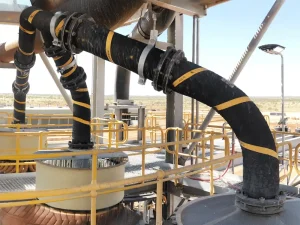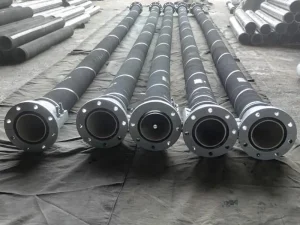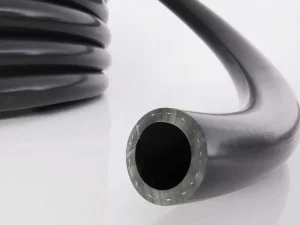L'industria mineraria è una delle più antiche e cruciali del mondo. Comporta la movimentazione di materiali pesanti e l'estrazione di minerali essenziali. Per svolgere queste operazioni pesanti, l'industria mineraria si affida a macchinari e strumenti potenti. Tra questi, il tubo flessibile da miniera è un pezzo di equipaggiamento trascurato ma cruciale. Ma cosa sono i tubi flessibili per miniere e come funzionano?
È una domanda frequente per chi è alle prime armi nel settore minerario. Tuttavia, la comprensione di questi tubi è altrettanto fondamentale per i professionisti per lavorare in modo più efficiente. Poiché sono disponibili in vari tipi, come scegliere il tubo più affidabile? Confusi? Non preoccupatevi! Questo articolo renderà tutto più semplice esplorando i tubi per miniere, i tipi, gli usi e i vantaggi. Iniziamo!
Cosa sono i tubi per miniere?

I tubi flessibili per l'industria mineraria sono tubi flessibili specializzati utilizzati nelle operazioni di estrazione. Questi tubi trasportano diversi materiali, come prodotti chimici e fanghi, da un luogo all'altro. Per questo motivo sono progettati appositamente per resistere agli ambienti minerari più difficili.
I tubi flessibili per l'industria mineraria sono utilizzati anche per collegare i diversi macchinari minerari. Spesso, nelle operazioni minerarie, le macchine sono distribuite su ampie aree. Ad esempio, è necessario collegare un tubo per liquami all'unità di lavorazione. In questo caso, i tubi metallici non sono pratici perché non possono piegarsi o spostarsi facilmente.
Pertanto, i tubi flessibili per miniere collegano queste parti grazie alla loro incredibile flessibilità e resistenza. Di conseguenza, le diverse parti del macchinario lavorano insieme senza problemi, anche nelle gallerie e nelle fosse. Ciò che rende speciali questi tubi è la loro versatilità. Sono disponibili in varie forme e dimensioni, che portano a diversi tipi. Ogni tipo svolge un compito specifico per il buon funzionamento dell'attività mineraria.
Composizione
Come detto in precedenza, i tubi da miniera devono affrontare diverse condizioni esterne difficili. Pertanto, la loro composizione comprende più strati per far fronte ai diversi ambienti. Vediamo come sono composti i tubi da miniera.
- Camera d'aria (rivestimento): Lo strato più interno tocca direttamente il materiale in movimento. Pertanto, questo strato deve essere liscio e resistente ai diversi materiali che trasporta. Per garantire tutti questi aspetti, questo strato è solitamente realizzato in gomma sintetica.
- Strato di rinforzo: La parte successiva e più importante è lo strato di rinforzo. Si tratta della sezione centrale che conferisce forza e resistenza alla pressione. Svolge un ruolo fondamentale nel prevenire lo scoppio e il collasso del tubo. Per questo motivo, è realizzato principalmente con fili d'acciaio, trecce tessili o corde di nylon.
- Copertura esterna: Questa parte del tubo da miniera funge da pelle. Protegge il tubo dai raggi UV, dalla luce solare, dall'abrasione e da altre condizioni difficili. Pertanto, deve essere resistente ai graffi e agli urti. A tal fine, questo strato esterno è realizzato in PVC o gomma.
Tipi di tubi da miniera
Spero che abbiate una conoscenza di base dei tubi da miniera. Giusto? Tuttavia, le operazioni di estrazione mineraria comportano molti compiti, come il trasporto di acqua e fanghi. Questi compiti richiedono un tubo flessibile con resistenza, flessibilità e materiali specifici. Ecco perché i tubi per miniere sono di vari tipi. Vediamo alcuni tipi comuni e il loro utilizzo.
1- Tubi per liquami

Come suggerisce il nome, questo tipo di tubo per miniere trasporta il liquame. Il liquame è una miscela di acqua, sabbia, rocce, minerali o fango. Si tratta di una miscela densa e pesante che deve essere gestita con attenzione. È qui che si trovano i tubi specializzati tubi per liquami entrano in gioco. A differenza dei tubi standard, sono robusti e durevoli.
Hanno uno spesso strato interno in gomma resistente all'usura. Questo rivestimento impedisce al tubo l'abrasione, l'inamidatura e lo scoppio. Lo strato di rinforzo di questi tubi è costituito da fili d'acciaio o strati di tessuto. Impedisce al tubo di collassare quando entra un liquame ad alta pressione. Questi tubi pompano principalmente liquami dal sito minerario all'impianto di lavorazione.
2- Tubi dell'aria e dell'acqua
I tubi per l'acqua e per l'aria sono i più comuni tubi da miniera. Anche se non trasportano materiali pesanti, sono essenziali per le attività minerarie quotidiane. Ad esempio, i tubi dell'acqua trasportano acqua pulita o pressurizzata in diversi siti minerari. L'acqua può essere utilizzata per la soppressione delle polveri, per il lavaggio delle parti dei macchinari o per il raffreddamento delle attrezzature.
D'altra parte, i tubi dell'aria forniscono aria compressa. Quest'aria è essenziale nel settore minerario in quanto alimenta strumenti come trapani, demolitori e sistemi pneumatici e di ventilazione. Pertanto, questi tubi sono progettati specificamente per resistere alla pressione dell'aria. Sia i tubi per l'acqua che quelli per l'aria contengono principalmente un rivestimento interno in gomma o PVC e uno strato extra resistente all'olio.
3- Tubi per prodotti chimici
I tubi chimici sono altri tipi di tubi da miniera che trasportano diverse sostanze chimiche. Nelle miniere, queste sostanze chimiche sono necessarie per trattare o separare i minerali preziosi. Tuttavia, la manipolazione di sostanze chimiche aggressive come acidi, solventi e oli è pericolosa. Possono consumare e danneggiare rapidamente la superficie del tubo ordinario.
Per prevenire questi problemi, produttori di tubi da miniera Per questi tubi flessibili si utilizzano rivestimenti interni speciali. Questo rivestimento è generalmente realizzato in polietilene, Teflon, Viton o gomma EPDM. Questi materiali non reagiscono con le sostanze chimiche ed evitano rotture e perdite. Pertanto, i tubi chimici sono utilizzati per la lisciviazione e l'estrazione di minerali con sostanze chimiche.
4- Tubi flessibili del carburante

I tubi flessibili per il carburante contribuiscono alla movimentazione di carburanti come la benzina e il gasolio durante l'attività estrattiva. Come è noto, l'attività estrattiva utilizza macchinari pesanti come trivelle, pale e generatori. Tutte queste macchine hanno bisogno di un rifornimento costante di carburante e olio per funzionare senza problemi. I tubi del carburante contribuiscono a far funzionare in modo efficiente i macchinari e le operazioni di estrazione.
Ad esempio, queste zappe trasferiscono il carburante dai serbatoi di stoccaggio ai veicoli minerari. Inoltre, aiutano a rifornire i generatori e i sistemi di alimentazione che si basano sul carburante. Questi liquidi infiammabili danneggiano il rivestimento dei tubi e possono causare esplosioni o crepe. Ecco perché questi tubi sono realizzati in neoprene, una miscela di PVC o gomma nitrilica.
5- Tubi flessibili resistenti al fuoco
I tubi flessibili resistenti al fuoco sono strumenti di sicurezza fondamentali per le aree ad alto rischio di incendio nelle miniere. Nei processi estrattivi, gli incendi possono verificarsi a causa di perdite di carburante, attrezzature calde o esplosioni. In questi casi, i tubi normali si sciolgono, bruciano e si rompono. Pertanto, questi tubi sono costruiti per funzionare efficacemente in condizioni di calore estremo o addirittura di incendio.
Vengono utilizzati per trasportare acqua, aria e fluidi idraulici nelle aree minerarie a rischio di incendio. Pertanto, i tubi flessibili resistenti al fuoco sono realizzati principalmente in EPDM, silicone e gomma sintetica. Per una maggiore protezione, contengono anche strati protettivi. Questi strati possono essere costituiti da fogli di alluminio in fibra di vetro e tessuti ignifughi.
6- Tubi di drenaggio
L'accumulo di acqua è comune nei siti minerari. La pioggia, le infiltrazioni o le operazioni di perforazione possono causare l'accumulo di acqua nei pozzi aperti o nelle miniere sotterranee. Se non viene rimossa, l'acqua può rallentare il processo di estrazione e danneggiare i macchinari. È qui che entrano in gioco i tubi flessibili da miniera per la disidratazione.
Si tratta di grandi tubi flessibili collegati alle pompe. Quando la pompa aspira l'acqua, questa viene spinta nei tubi flessibili per il drenaggio. Questi tubi trasportano poi l'acqua in modo sicuro verso luoghi di drenaggio come fosse o stagni. Questi tubi per il drenaggio utilizzano una gomma rinforzata per evitare che si attorcigli e garantire un movimento fluido dell'acqua.
7- Tubi flessibili per il vuoto
I tubi flessibili per il vuoto sono tubi per impieghi gravosi che aspirano i materiali indesiderati. Questi materiali sciolti includono fanghi, polvere, particelle fini, piccole rocce e detriti. Si accumulano nei siti minerari, intasano i macchinari e rallentano le operazioni. I tubi flessibili per l'aspirazione aiutano quindi a ripulire la polvere e altri detriti. Ma come funzionano questi tubi?
Questi tubi sono collegati a un sistema di aspirazione che li attraversa. I tubi inviano quindi i detriti ai bidoni di raccolta, ai serbatoi o ai siti di smaltimento. In altre parole, a differenza dei normali tubi flessibili, essi aspirano i detriti utilizzando la pressione negativa e funzionano al contrario. Il rivestimento interno di questi tubi è liscio per consentire una gestione agevole di polvere e fango. Consente un flusso facile e una velocità di pulizia elevata.
8- Tubo da miniera a Y
Un tubo flessibile di estrazione è una struttura speciale con connettori a forma di Y. Come la lettera Y, questi tubi hanno un ingresso e due uscite o viceversa. Questa forma consente di dividere un tubo in due o di combinare due tubi in uno. Ad esempio, si utilizza un tubo a Y per inviare l'acqua da un tubo a due macchine durante l'estrazione mineraria.
Allo stesso modo, se si desidera raccogliere il liquame da due aree e inviarlo in un unico tubo, questi tubi saranno utili. I tubi flessibili a Y sono quindi un modo intelligente per gestire la direzione e la distribuzione dei fluidi. Questi tubi sono realizzati principalmente in metallo resistente o in gomma rinforzata. Questa composizione consente loro di gestire due diverse pressioni in condizioni minerarie difficili.
Vantaggi dei tubi da miniera
I tubi flessibili per l'industria mineraria possono sembrare semplici tubi flessibili. Tuttavia, sono un elemento vitale per il buon funzionamento di ogni operazione mineraria. Ma non è tutto. In questa sezione esploriamo i vari vantaggi dei tubi da miniera.
1- Flessibilità e mobilità
Uno dei vantaggi più significativi dei tubi da miniera è la loro flessibilità. A differenza dei tubi metallici, sono realizzati principalmente in gomma. Pertanto, è possibile piegarli e torcerli facilmente per scopi diversi. Ad esempio, se un minatore vuole spostare il tubo da una posizione all'altra. Non deve ricostruire l'intero sistema, ma può riposizionarli così come sono. Inoltre, la loro flessibilità si rivela utile anche per piegare intorno agli angoli e tra le rocce. Questa facile mobilità riduce i tempi di inattività e rende efficiente l'intera attività estrattiva.
2- Resistenza all'usura
Come sapete, il settore minerario è un lavoro duro e impegnativo. I tubi flessibili utilizzati in questo processo devono affrontare alta pressione, abrasione e altre condizioni difficili. Per questo motivo, i tubi da miniera sono realizzati con materiali robusti come la gomma rinforzata e il PVC. Questi materiali li proteggono dall'attrito causato da sabbia, ghiaia o fango. Inoltre, prevengono i tubi dagli urti e dalle sostanze chimiche che possono causare lo scoppio.
3- Prestazioni elevate in condizioni difficili
L'estrazione mineraria non avviene in luoghi tranquilli e silenziosi. Spesso si svolge in gallerie sotterranee dure ed estreme. In queste aree difficili, gli strumenti devono essere sufficientemente robusti per continuare a lavorare in modo efficiente. Ecco perché i tubi flessibili per miniere sono realizzati con materiali resistenti come la gomma sintetica. Questi materiali rendono il tubo resistente al calore per gestire i fluidi caldi. Possono anche resistere al freddo e al gelo senza rompersi.
4- Sicurezza
La sicurezza è la priorità assoluta nelle miniere. I lavoratori hanno a che fare con sistemi ad alta pressione, rocce taglienti e sostanze chimiche pericolose. Se una parte del sistema si guasta, può provocare gravi incidenti e lesioni. I tubi flessibili per miniere sono progettati per gestire materiali corrosivi e condizioni difficili. Non scoppiano, non si rompono e non si spezzano in nessuna condizione. Pertanto, offrono un trasferimento a prova di perdite di diversi materiali pericolosi e prevengono le deformazioni.
5- Efficiente dal punto di vista dei costi
In generale, le operazioni minerarie sono costose. Pertanto, è essenziale utilizzare attrezzature efficaci dal punto di vista dei costi per ridurli. Un esempio di questo tipo di strumento sono i tubi flessibili per miniere. Questi tubi possono sembrare piccoli, ma fanno risparmiare molto denaro. COME? Come ho detto sopra, questi tubi flessibili sono resistenti. Possono affrontare efficacemente ogni tipo di ambiente. Ciò riduce la necessità di nuovi acquisti e riparazioni. Di conseguenza, il costo complessivo della manutenzione e delle frequenti sostituzioni si riduce.
6- Applicazioni versatili
Un altro vantaggio significativo dei tubi da miniera è la loro versatilità. Ciò significa che possono essere utilizzati in modi diversi per vari compiti. Ad esempio, possono trasportare fluidi ad alta pressione come fanghi e acqua calma. Questi tubi aiutano anche a trasportare aria compressa, prodotti chimici aggressivi e carburanti. Inoltre, i tubi per miniere sono progettati per far fronte a diverse condizioni ambientali. In questo modo, la loro capacità di svolgere più compiti rende efficiente l'attività mineraria sotterranea e a cielo aperto.
Usi dei tubi da miniera
Avete già appreso le nozioni di base sui tubi da miniera, i loro tipi e i loro vantaggi. Ma spesso ci si pone una domanda: Dove si inseriscono esattamente nel settore minerario? Prima di concludere, vediamo di esplorare alcune applicazioni tipiche dei tubi da miniera.
1- Trasporto del materiale
Uno degli usi principali dei tubi per miniere è il trasporto di materiali da un luogo all'altro. Nel settore minerario, il materiale più comunemente trasferito è il liquame. Questa miscela di sabbia e acqua deve essere spostata dai siti di estrazione alle unità di lavorazione. Come è noto, si tratta di un materiale molto ruvido e abrasivo, per cui i tubi flessibili per miniere lo trasferiscono in modo efficiente.
2- Controllo della polvere
Le attività estrattive, come la perforazione e la frantumazione, producono molta polvere. Le particelle di polvere possono ostacolare il funzionamento efficiente dei macchinari e causare problemi ai lavoratori. Ecco perché la rimozione della polvere nelle miniere sotterranee e di superficie è fondamentale. I tubi flessibili per miniere aiutano a controllare la polvere spruzzando acqua o aspirandola con il vuoto. Questi tubi sono molto flessibili e possono essere spostati nei siti minerari in cui si produce la polvere.
3- Apparecchiature di raffreddamento
Le macchine per l'estrazione mineraria lavorano spesso per molte ore, causando un accumulo di calore. Se questo calore non viene gestito, può danneggiare la macchina e causare gravi guasti. È qui che entrano in gioco i tubi flessibili per l'industria mineraria. Trasportano refrigeranti o liquidi particolari nelle aree calde dei macchinari. Questi liquidi assorbono il calore e poi viaggiano sul tubo fino alle stazioni di raffreddamento. Questi tubi sono generalmente resistenti al calore e possono gestire anche fluidi caldi.
4- Trasferimento chimico
Nelle operazioni minerarie, le sostanze chimiche vengono utilizzate per diversi compiti. Una volta estratti i materiali, è necessario procedere all'estrazione dei minerali preziosi. In questa fase si utilizzano sostanze chimiche come acidi, solventi e reagenti. Queste sostanze chimiche separano l'oro, il rame e altri metalli dal minerale. A questo scopo, i tubi da miniera trasportano questi prodotti aggressivi e li trasferiscono nel luogo richiesto.
5- Apparecchiature di collegamento
I siti minerari contengono macchinari pesanti, tra cui tubazioni, serbatoi e pompe. A volte, queste parti devono essere collegate per garantire il corretto svolgimento delle operazioni minerarie. Per questo motivo, i tubi flessibili per miniere a T e a Y collegano questi componenti. Ad esempio, collegano i serbatoi d'acqua alle trivelle e le pompe alle condutture dei liquami. Collegano anche le fonti di carburante ai generatori.
Consigli per la manutenzione e la sicurezza dei tubi da miniera
I tubi flessibili per l'industria mineraria sono strumenti fondamentali per il buon funzionamento dell'attività estrattiva. Ma se non vengono curati adeguatamente, si deteriorano rapidamente e causano perdite. Ciò può comportare perdite finanziarie e perdita di tempo. Quindi, come vi prenderete cura dei tubi da miniera? Non lo sapete? Non temete! Ci sono alcuni consigli per la manutenzione!
- Ispezione regolare: I tubi per l'industria mineraria vengono utilizzati continuamente in condizioni difficili. Una piccola crepa può trasformarsi in un problema più grave. Pertanto, è bene verificare la presenza di segni di crepe, perdite e rigonfiamenti.
- Pulire dopo l'uso: I tubi da miniera accumulano polvere e sostanze nocive durante il lavoro. Pertanto, dopo aver utilizzato questi tubi, è necessario lavarli e pulirli. In questo modo si evita l'intasamento o il blocco dei macchinari.
- Conservare correttamente: Una corretta conservazione evita l'usura dei tubi nel tempo. Pertanto, quando non vengono utilizzati, riponeteli correttamente. Inoltre, evitare di torcere o piegare eccessivamente i tubi durante lo stoccaggio e avvolgerli in modo lasco.
- Fissare i raccordi: I raccordi sono parti del tubo che si collegano ad altri tubi o parti. Se questo raccordo è allentato, può causare perdite. Assicuratevi quindi sempre che questi raccordi siano in buone condizioni e che siano serrati correttamente.
- Sostituire i tubi flessibili usurati: I tubi flessibili non sono destinati a durare per sempre. A causa dell'uso continuo in condizioni difficili, possono usurarsi. Pertanto, quando si notano questi segni, è necessario sostituirli immediatamente.
Conclusione
I tubi flessibili per l'industria mineraria sono strumenti semplici ma potenti che aiutano le industrie minerarie a lavorare senza problemi. Le operazioni minerarie, come il trasporto di forniture e prodotti chimici, sarebbero complicate senza di essi. Per questo motivo, questi tubi sono disponibili in vari tipi per gestire le diverse attività minerarie. Tutti questi tipi variano in termini di materiali, uso e gestione.
Ad esempio, alcune case sono appositamente attrezzate per il trasporto di sostanze chimiche e fluidi aggressivi. Altri, invece, sono in grado di trasportare aria compressa e acqua. Conoscendo le caratteristiche di ciascun tipo, la scelta del tubo giusto è molto più semplice. Infine, in questo articolo ho esplorato anche i loro vantaggi e utilizzi. Questo aspetto rende la scelta più semplice.
